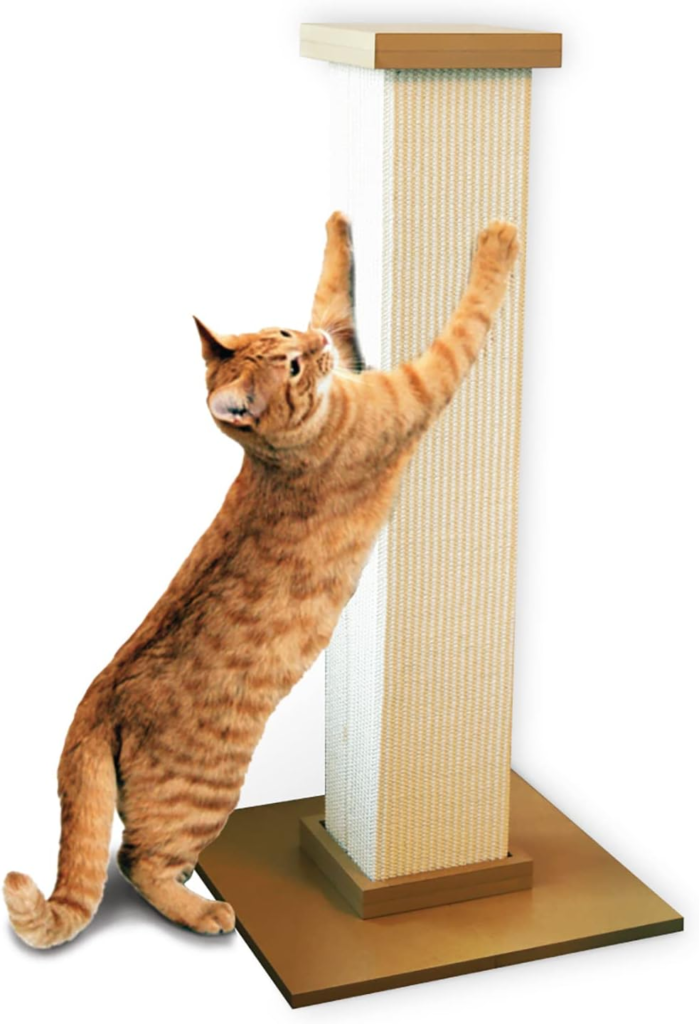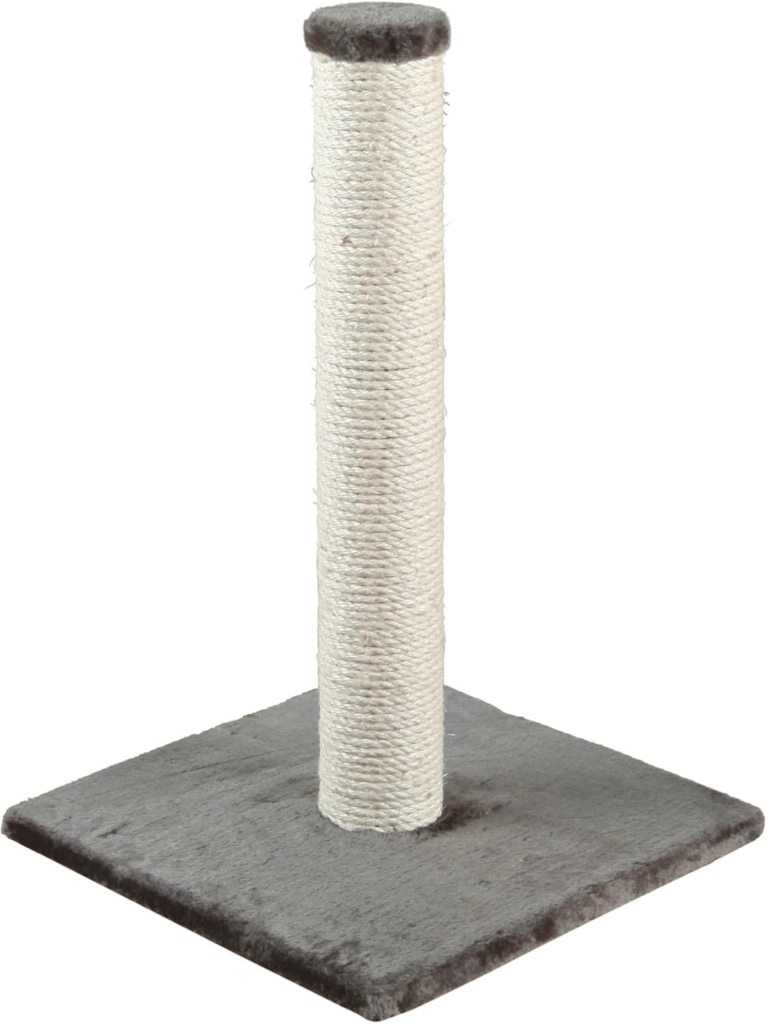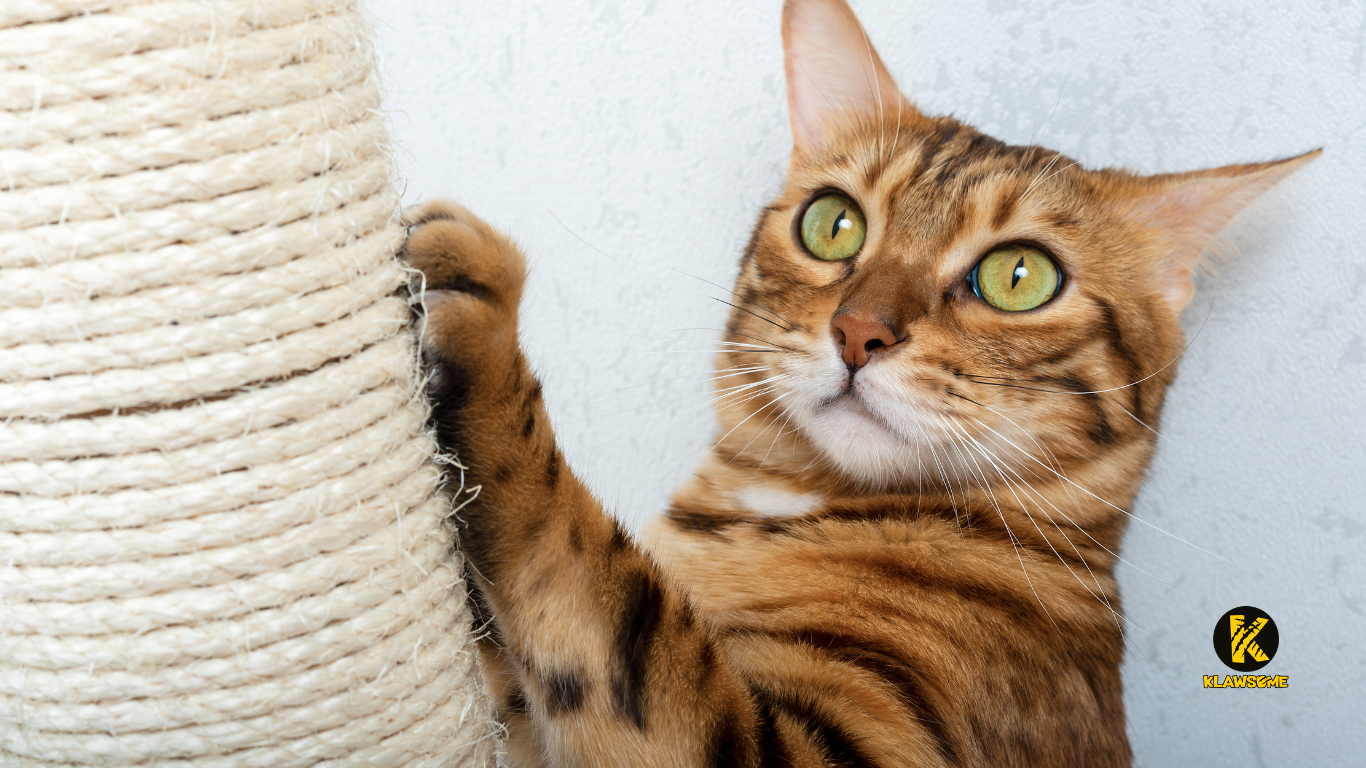I. Introduction
If you’ve ever lived with a cat, you’ve likely witnessed the chaos of a feline on a mission—shredded couch arms, frayed rugs, and claw marks on wooden furniture. At some point, you’ve probably wondered: Do scratching posts really work, or are they just another pet store gimmick?
Scratching is an instinctive behavior in cats. It’s not just about keeping their claws sharp; it’s a form of communication, stress relief, and exercise. But as much as cats love to scratch, their human companions don’t always love the destruction that comes with it. That’s where scratching posts come in—designed to provide a designated place for cats to satisfy their natural urges without ruining your furniture.
But do they actually work? Do cats prefer scratching posts over your expensive couch, or is it just wishful thinking? In this article, we’ll take a deep dive into why cats scratch, what makes a scratching post effective, and how you can train your feline friend to use one instead of your favorite armchair. If you’re tired of playing defense against your cat’s claws, read on—you might just find the solution you’ve been looking for.
II. Understanding Why Cats Scratch
To truly understand whether scratching posts work, we first need to explore why cats scratch in the first place. Contrary to what many people believe, cats don’t scratch just to be destructive or out of spite. It’s a natural and necessary behavior tied to their instincts, physical health, and even emotional well-being.
1. Marking Their Territory
Cats are territorial creatures, and scratching is one of the ways they claim their space. When a cat scratches, it leaves both a visual mark and a scent mark. Their paw pads contain scent glands that release pheromones, which serve as a signal to other animals (or even to themselves) that a particular area belongs to them. This is especially important in multi-cat households, where territorial boundaries need to be established.
2. Maintaining Claw Health
Scratching helps cats shed the outer layers of their claws, keeping them sharp and healthy. Unlike dogs, whose nails continuously grow and require trimming, a cat’s claws naturally renew themselves by shedding old layers. If they don’t have an appropriate surface to scratch, their claws can become overgrown, uncomfortable, and even lead to health issues.
3. Stretching and Strengthening Muscles
Think of scratching as a feline version of a full-body stretch. When a cat digs its claws into a surface and pulls down, it stretches out its back, shoulders, and leg muscles. This movement helps keep their muscles flexible and strong, much like how yoga helps humans maintain mobility.
4. Stress Relief and Emotional Expression
Scratching is not just physical—it’s also deeply emotional. Cats scratch when they’re excited, stressed, or even just happy. Some cats will scratch more when they’re anxious or adjusting to a new environment, while others will scratch enthusiastically after a nap or play session. If your cat has suddenly started scratching more than usual, it might be worth looking at any changes in their environment that could be causing stress.
5. Communication with Other Cats
In a multi-cat household, scratching serves as a form of communication. The combination of scent marks, claw marks, and even the act of scratching itself sends signals to other cats about dominance, boundaries, or presence. This is why some cats prefer to scratch in highly visible areas—like the couch or the front of the carpet—rather than tucked-away places.
6. Habit and Learned Behavior
Cats are creatures of habit. If they’ve been scratching your furniture for years, they’re not just doing it out of necessity—they’ve developed a habit. That’s why simply buying a scratching post isn’t enough; you have to train your cat to use it by making it more appealing than your furniture.
So, Where Do Scratching Posts Fit In?
Now that we understand why cats scratch, the big question remains: can a scratching post satisfy these instincts effectively? The answer depends on choosing the right post, placing it strategically, and encouraging your cat to use it—all of which we’ll cover in the next section.
If you’ve ever wondered why your cat ignores the fancy scratching post but loves your couch, keep reading—you might just be making a simple mistake that’s easy to fix.
III. Do Scratching Posts Work? Scientific & Behavioral Evidence
If you’ve ever bought a scratching post, set it up in the perfect spot, and then watched in frustration as your cat completely ignored it, you might be wondering if these products actually work. The truth is, scratching posts can be extremely effective, but only when they meet a cat’s natural preferences and instincts. Let’s take a look at the scientific and behavioral evidence behind scratching posts and whether they truly deter cats from destroying furniture.
1. Scientific Research on Scratching Behavior
Several studies on feline behavior suggest that cats prefer certain types of scratching surfaces over others. Researchers have found that:
- Cats have strong texture preferences. A 2018 study in the Journal of Feline Medicine and Surgery found that most cats preferred sisal-covered posts over carpet or cardboard. This is likely because sisal provides strong resistance and allows cats to sink their claws in deeply.
- Height and stability matter. A study published in Applied Animal Behaviour Science showed that cats tend to choose scratching posts that are tall enough to allow full-body stretching and sturdy enough not to wobble or tip over. If a post is too short or unstable, many cats will ignore it.
- Scratching is a deeply ingrained instinct. No matter how much a cat is trained, scratching cannot be “unlearned”—it can only be redirected. This is why providing an appealing scratching post is crucial.
2. What Do Veterinarians and Behaviorists Say?
Animal behaviorists widely agree that scratching posts work when used correctly. According to feline behavior expert Dr. Mikel Delgado:
“Scratching is a necessary behavior for cats. If they don’t have an appropriate surface to scratch, they will find their own—like your furniture. The key is offering an attractive and well-placed alternative.”
Veterinarians also emphasize the importance of scratching posts for physical and emotional well-being. Cats that do not have a proper scratching outlet may experience:
- Increased stress and anxiety
- Overgrown claws leading to pain or infection
- Destructive behavior due to frustration
3. Real-World Evidence: Do Cats Actually Use Scratching Posts?
If scratching posts didn’t work, they wouldn’t be one of the most popular cat products on the market. Many cat owners report a significant decrease in furniture damage after introducing a well-placed, high-quality scratching post. However, the key to success often depends on how the post is introduced and whether it matches the cat’s preferences.
4. Why Some Cats Ignore Scratching Posts (and How to Fix It)
While scratching posts can be highly effective, they sometimes fail—often due to human error. Here are common reasons why a cat might reject a scratching post:
| Reason | Solution |
|---|---|
| Wrong material (e.g., soft carpet instead of sisal) | Choose a sisal-wrapped or natural wood post |
| Post is too short or unstable | Get a taller, heavier post that allows full-body stretching |
| Bad placement (e.g., hidden in a corner) | Place the post near the cat’s usual scratching area (e.g., next to the couch) |
| No incentive to use it | Sprinkle catnip, use treats, or engage in play near the post |
| Old habits are hard to break | Redirect scratching behavior with positive reinforcement |
5. The Verdict: Do Scratching Posts Really Work?
Yes—but only if they meet a cat’s natural needs. Scratching posts that are tall, sturdy, made of the right material, and placed in the right location are far more likely to be used. If a cat continues to scratch furniture, the problem is often with the scratching post itself—not the idea of scratching posts in general.
In the next section, we’ll dive into how to choose the right scratching post and ensure your cat actually uses it. If your cat has ever ignored a post before, stay tuned—you might be making one simple mistake that’s easy to fix.
IV. Choosing the Right Scratching Post for Your Cat
Not all scratching posts are created equal. If your cat has ever ignored a post in favor of your couch, chances are it wasn’t the right fit. The key to success lies in selecting a scratching post that aligns with your cat’s natural instincts—one that’s sturdy, the right height, and made from the right materials. Here’s what to look for when choosing the perfect scratching post for your feline friend.
1. Key Features of an Effective Scratching Post
- Material Matters – Most cats prefer sisal fabric or rope because it provides a satisfying texture for clawing. Avoid carpet-covered posts, as they can confuse cats into thinking your actual carpet is fair game.
- Height & Stability – Cats love to stretch fully when they scratch. A post that’s too short won’t be appealing, and a wobbly one may scare them away. Look for at least a 24-inch post for kittens and smaller cats, and over 30 inches for adult cats.
- Vertical vs. Horizontal Preference – Some cats prefer scratching upright (like on a tree trunk), while others like horizontal scratchers. Observing your cat’s current scratching habits can help you choose the right style.
- Placement Is Key – Scratching posts should be placed near the areas your cat already scratches (e.g., next to the couch or in their favorite lounging spot).
2. Best Scratching Posts for Different Needs
If you’re looking for a high-quality scratching post that will keep your cat engaged and protect your furniture, here are some of the best options:
For Adult Cats: SmartCat Ultimate Scratching Post (32 Inches)

✅ Why it’s great:
- Made from durable sisal fabric, which cats love
- Tall enough (32 inches) for a full-body stretch
- Heavy, stable base prevents tipping
This post is one of the top-rated scratching posts for a reason—it’s sturdy, long-lasting, and designed to appeal to a cat’s natural instincts. If you’ve struggled to get your cat to use a scratching post, this one is a game-changer.
For Small Cats & Kittens: MECOOL Cat Scratching Post (22 Inches)

✅ Why it’s great:
- Perfect height (22 inches) for kittens and small cats
- Comes with a hanging ball toy for extra engagement
- Compact and stylish for small spaces
If you’re introducing a scratching post to a kitten or have a small cat that doesn’t need a tall tower, this kitten-friendly option is a fantastic choice. The added toy makes it extra fun for young, playful cats.
For a Budget-Friendly, Sturdy Option: TRIXIE Parla Cat Scratching Post (24.25 Inches)

✅ Why it’s great:
- Durable sisal rope wrapping for long-lasting use
- Compact yet tall enough for most cats
- Soft fabric-covered base adds comfort
This is a solid, affordable option for cat owners who want something simple but effective. It’s sturdy, well-built, and ideal for cats who enjoy vertical scratching.
3. What If My Cat Still Scratches the Furniture?
If your cat isn’t immediately drawn to the scratching post, try these tricks:
- Use catnip or treats to make the post more appealing.
- Gently guide your cat to the post and reward them when they use it.
- Place it near their favorite scratching spot (e.g., next to the couch).
- Play around the post to create a positive association.
Final Thoughts
Scratching posts do work—but only if they meet your cat’s needs. Investing in a tall, sturdy, and sisal-covered post will drastically increase the chances of your cat using it consistently. If you’re ready to protect your furniture while keeping your cat happy, consider trying one of the highly-rated scratching posts recommended above.
In the next section, we’ll cover how to train your cat to use a scratching post, so you can say goodbye to shredded furniture for good!
V. Training Your Cat to Use a Scratching Post
Buying the best scratching post is only half the battle—getting your cat to actually use it is where the real challenge begins. Some cats take to a new scratching post immediately, while others need a little encouragement. If your feline friend is still eyeing your furniture despite having a perfectly good post, don’t worry—with the right approach, you can train your cat to use it consistently.
1. Make the Scratching Post Irresistible
Cats are naturally curious, but sometimes they need a little extra motivation to use their new scratching surface. Here are some effective ways to attract them to it:
- Use Catnip or Pheromone Sprays – Sprinkle catnip on the post or use a feline pheromone spray like Feliway to make the post more appealing. Many cats can’t resist rubbing and scratching where catnip is applied.
- Reward with Treats – When your cat interacts with the scratching post (even just sniffing or touching it), immediately reward them with a treat. This builds a positive association with the post.
- Play Around the Post – Dangle a wand toy or toss a ball near the post to encourage your cat to engage with it naturally.
2. Place the Scratching Post in the Right Location
The placement of the scratching post is just as important as the post itself. Cats scratch for territorial marking, stretching, and habit, so putting the post in a convenient and familiar spot makes a huge difference.
✅ Best places to put a scratching post:
- Near your cat’s favorite resting area (they love to stretch and scratch after waking up).
- Next to furniture they already scratch (so they have a better alternative).
- In a high-traffic area where they naturally pass by and interact with it.
❌ Worst places for a scratching post:
- In a hidden corner or an unused room (out of sight, out of mind).
- Too close to food and water bowls (cats prefer separate spaces for eating and scratching).
3. Redirect Your Cat’s Scratching Behavior
If your cat is still scratching your furniture, never punish them—instead, gently redirect them to the scratching post. Here’s how:
- Catch Them in the Act – If you see your cat scratching something inappropriate, interrupt them with a gentle noise (like a clap or a “psst” sound).
- Guide Them to the Scratching Post – Immediately take them to the scratching post and encourage them to use it by scratching it yourself or using a toy.
- Reward Positive Behavior – As soon as your cat uses the scratching post, offer praise, treats, or playtime to reinforce the good habit.
4. Protect Your Furniture in the Meantime
While your cat is learning to use the scratching post, you may need to temporarily protect your furniture from further damage. Here are some effective deterrents:
- Use Double-Sided Tape – Cats dislike sticky surfaces, so applying double-sided tape to their favorite scratching spots can discourage them.
- Try Furniture Covers or Slipcovers – Covering the areas your cat scratches can make them less appealing.
- Use Citrus or Vinegar Sprays – Many cats dislike the smell of citrus or vinegar-based sprays (always test on fabric first).
5. Be Patient and Consistent
Some cats will start using a scratching post immediately, while others may take a few weeks to develop the habit. Consistency is key—keep reinforcing the behavior and avoid switching posts too often, as cats prefer familiarity.
Common Mistakes to Avoid:
❌ Expecting your cat to automatically know how to use the post.
❌ Scolding or punishing your cat for scratching furniture.
❌ Placing the post in an area where your cat never goes.
❌ Choosing a post that’s too short, unstable, or covered in the wrong material.
Final Thoughts
Training your cat to use a scratching post isn’t difficult, but it does require a little patience and strategy. By choosing the right post, placing it in an ideal location, and using positive reinforcement, you’ll set your cat up for success. Once your cat gets into the habit of using a scratching post, they’ll be far less likely to target your furniture—making both of you happier in the long run!
Next, we’ll dive into managing unwanted scratching behavior and how to protect your home while your cat adjusts to using their new scratching outlet. Stay tuned!
VI. Managing Unwanted Scratching Behavior
Even with the best scratching posts and alternatives, some cats still insist on digging their claws into furniture, carpets, or walls. While scratching is a natural behavior, it can be frustrating when it leads to damaged furniture, shredded rugs, or scratched-up door frames. The key to stopping unwanted scratching is a combination of deterrents, redirection, and positive reinforcement. Here’s how to protect your home while ensuring your cat has a healthy outlet for their scratching instincts.
1. Protect Your Furniture from Claw Damage
If your cat has a favorite piece of furniture they love to scratch, take steps to make it less appealing while they adjust to using a scratching post.
✅ Use Double-Sided Tape
- Cats dislike sticky surfaces, so applying double-sided tape like Sticky Paws to furniture edges can deter them.
- Place it on couch arms, table legs, or anywhere your cat scratches.
✅ Use Furniture Covers or Slipcovers
- Cover frequently scratched areas with washable slipcovers to protect the fabric.
- Temporary plastic protectors can discourage scratching until your cat builds a habit of using a scratching post.
✅ Try a Citrus or Vinegar Spray
- Cats dislike the scent of citrus and vinegar, so lightly spraying a natural deterrent on furniture can keep them away.
- DIY Recipe: Mix water + apple cider vinegar (1:1 ratio) or use a citrus-scented pet-safe spray.
✅ Use Cat Scratch Guards
- Plastic furniture shields like Sofa Scratcher Guards can be attached to the sides of couches and chairs to block scratching.
2. Trim Your Cat’s Nails Regularly
Keeping your cat’s claws trimmed reduces the damage they can do if they scratch in unwanted places.
✅ How Often?
- Every 2–4 weeks, depending on how fast their claws grow.
✅ Best Tools:
- Guillotine-style clippers or grinder tools like the Dremel Pet Nail Grooming Kit work well.
- If your cat resists nail trimming, try doing one paw at a time and rewarding them after each session.
✅ Consider Soft Nail Caps
- Vinyl claw covers like Soft Paws can be applied to your cat’s claws to prevent scratching damage.
- These fall off naturally after a few weeks and are a safe, non-permanent solution.
3. Provide Mental & Physical Stimulation
Bored or anxious cats may scratch destructively out of frustration. Keeping them engaged mentally and physically can reduce problem scratching.
✅ Interactive Playtime
- Use wand toys, laser pointers, or puzzle feeders to burn excess energy.
- A tired cat is less likely to scratch out of boredom!
✅ Increase Vertical Space
- Install cat shelves, window perches, or a cat tree to encourage climbing instead of destructive scratching.
- Cats that have vertical territory feel more secure and may scratch less due to stress.
✅ Provide Multiple Scratching Options
- Place at least one scratching post per room to ensure there’s always a proper outlet nearby.
- Different textures (sisal, cardboard, carpet) help cater to different scratching preferences.
4. Redirect & Reinforce Positive Behavior
If you catch your cat scratching something they shouldn’t, never yell or punish them—this only creates fear and confusion. Instead, use these steps:
- Interrupt Gently – Make a soft noise (like a “psst” sound) to stop them without scaring them.
- Redirect to the Scratching Post – Guide them to the post and encourage them to scratch by using catnip, treats, or a toy.
- Reward Immediately – The moment your cat scratches the post instead of the furniture, give them praise, a treat, or playtime.
🛑 What NOT to Do:
❌ Do not punish your cat – This will only make them anxious and more likely to scratch in secret.
❌ Do not declaw – Declawing is cruel, painful, and can cause long-term behavioral and health issues.
5. When to Seek Professional Help
If your cat continues to scratch excessively despite redirection and deterrents, it may be due to stress, anxiety, or a medical issue. Signs that professional help may be needed include:
- Excessive scratching combined with aggression
- Sudden increase in destructive scratching (especially if it started after a change in routine)
- Signs of anxiety or territorial marking (e.g., urine marking along with scratching)
A veterinarian or cat behaviorist can help identify underlying causes and recommend behavioral modifications or stress-reducing solutions.
Final Thoughts
Managing unwanted scratching is all about understanding your cat’s natural instincts while providing appropriate alternatives. With the right deterrents, redirection, and positive reinforcement, you can successfully train your cat to scratch in designated areas—protecting your home while keeping your feline happy.
In the final section, we’ll answer the big question: Are scratching posts really worth it? Stay tuned for the verdict!
VII. Conclusion: Are Scratching Posts Worth It?
So, do scratching posts really work? Yes—but only if you choose the right one and use it effectively.
Scratching is a natural, instinctive behavior for cats, and no amount of training will make them stop entirely. However, with the right approach, you can redirect their scratching to appropriate surfaces, saving your furniture from destruction while keeping your cat happy and healthy.
Key Takeaways:
✅ Scratching is essential for cats – It helps them mark territory, maintain claw health, stretch muscles, and relieve stress.
✅ Scratching posts DO work – But they need to be sturdy, tall enough, and made of the right material (like sisal) to be effective.
✅ Placement matters – A scratching post stuck in a corner won’t get used. Put it near your cat’s usual scratching spots for best results.
✅ Training takes patience – Using catnip, toys, treats, and positive reinforcement can help encourage your cat to use a scratching post.
✅ Alternatives exist – If your cat ignores traditional scratching posts, scratching pads, wall-mounted scratchers, or cat trees may work better.
✅ Furniture protection can help – Until your cat consistently uses a post, double-sided tape, deterrent sprays, and furniture protectors can prevent damage.
Final Verdict: Are Scratching Posts Worth It?
Yes! Scratching posts are one of the best investments for cat owners. They provide an essential outlet for natural scratching behavior while protecting your furniture and reducing destructive habits.
If your cat has ignored scratching posts in the past, don’t give up! Choosing the right type, placing it strategically, and using training techniques can make all the difference. With a little patience and the right approach, your cat will be happily scratching where they should—and you’ll finally have a claw-free couch.
Your Next Steps:
🛒 If you’re ready to upgrade your cat’s scratching experience, check out these top-rated scratching posts:
- Best Overall: SmartCat Ultimate Scratching Post (32 Inches) – Tall, sturdy, and made from durable sisal.
- Best for Kittens & Small Cats: MECOOL Cat Scratching Post (22 Inches) – Compact with a fun hanging toy.
- Best Budget Option: TRIXIE Parla Cat Scratching Post (24.25 Inches) – Affordable and effective.






